THE BREASTPLATE OF THE HIGH PRIEST
by Harold Meij H.P.
Tokyo Chapter #1, R.A.M.
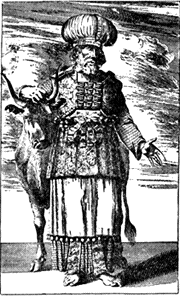
“And Aaron shall bear the names of the children of Israel in
the breastplate of judgment upon his heart when he goeth in unto the holy place
for a memorial before the Lord continually”. [Exodus 28.29]
Aaron was the first high priest and was Moses' brother. After
Aaron died, subsequent high priests were his descendants, the sons of Aaron. The
High Priest was the most glorious Jewish position. His representative dress was
said to be “for glory and for beauty.” It was made according to the design given
by God to Moses. Only certain special people were allowed to make the garment as
the following verse indicates:
“And thou shalt speak unto all that are wise-hearted, whom I
have filled with the spirit of wisdom, that they may make Aaron's garments to
consecrate him that he may minister unto me in the priest's office”[v.
3].
The role of the breastplate becomes clear in the following
text:
“Aaron shall bear the names of the children of Israel in the
breastplate of judgment upon his heart when he goeth in unto the holy place, for
a memorial before the Lord continually”
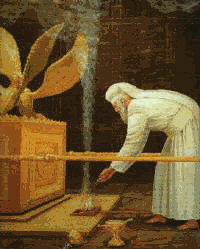
Why is the Breastplate so important?
The breastplate was of great importance because by means of it,
God revealed his Divine will to His chosen people. It was designed by God
Himself and the directions as to how it was to be made were given to Moses as
illustrated in Exodus xxviii. 15, 20.
The King James Authorized Version of the Bible (1769)
translated the Hebrew work “chosen" as breastplate, but this obscures some of
its meaning. In the Septuagint it is written by the Greek word "logeion," which
means a speaking-place. This describes exactly what the breastplate really
was---the oracle or means by which God spoke to, i.e., answered the inquires of,
the high-priest.
What did the Breastplate look like?
The breastplate was clearly designed with the idea that the
names of the twelve tribes engraved on the stones should be brought before God
“as a continual memorial,” and that Aaron should “bear them upon his heart, when
he went into the most holy place.” (Exodus xxviii. 12, 29). When we look at the
breastplate as we use in our ritual, we find it to be made of metal with 12
gems. However, in reality, according to the Bible, the breastplate, or, as it is
further named, the breastplate of judgment was, like the inner curtains of the
tabernacle, of "cunning work," which means that it was the work of a skilled
weaver. The material with which it was woven consisted of threads of gold and
blue, purple and scarlet linen threads. The number of the threads and the order
of the colors were, according to the "Targums” one of gold, six of blue, six of
purple, and six of scarlet.
The Urim and Thummim
The breastplate was actually made of two pieces, which formed a
sort of purse, or bag, in which also was kept the two sacred stones, named the
Urim (representing light and excellence) and the Thummim (representing
perfection and completion). These stones were some divinely appointed
instruments by which the High Priest inquired of God about matters concerning
the welfare of the children of Israel. The Bible makes several references to
these miraculous stones, but not anything physical, like the shape or size.
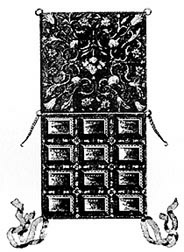
They were probably two jewels.
When someone had to make an important decision, the request was made known to
the high priest. He would stand before the Lampstand, holding the Urim in one
hand and the Thummin in the other. As the light reflected from the Urim and the
Thummin onto the stones of the Breastplate, this flash of light provided up to
24 combinations (2 x 12). Since there are 22 letters in the Hebrew alphabet, the
flashes of light could produce strings of letters. As God breathed through the
Ark, the Veil would move, permitting a breeze to flicker the flames in the
Lampstand to momentarily alter the angle of direction of the light onto the Urim
and Thummin, and thence to the Breastplate. Thus God was able to communicate
directly, but not audibly, to the high priest and answer the enquiry.
Which stones were on the breastplate?
Upon the breastplate were set four rows of precious stones,
three in each row, and upon them were engraved the names of the twelve tribes,
and as the great Jewish historian Josephus adds, "in the order of their birth",
but we are not told which stone to which tribe. So which stones were used? This
is a 2,000 year old question. Although the Hebrew names of the 12 stones are not
in question, their translation is, and despite numerous attempts, the various
translators cannot, to date, agree to a single translation. G. W. Kunz in "The
Curious Lore of Precious Stones" says: “In the Midrash Bemidbar, the Rabbinical
commentary on numbers, the tribes are given in their order, with the stones
appropriate to each and the color of the tribal standard pitched in the desert
camp, this color corresponding in each case with that of the tribal stone”.
In general, however, the following composite is most
accepted:
|
Judah
Sardius
(Red) |
Issachar
Topaz
(Pale green) |
Zebulon
Carbuncle
(Deep red) |
|
Reuben
Emerald
(Green) |
Simeon
Sapphire
(Deep blue) |
Gad
Diamond
(Transparent) |
|
Ephraim
Ligure
(Dull red) |
Manasseh
Agate
(Gray) |
Benjamin
Amethyst
(Purple) |
|
Dan
Beryl
(bluish green) |
Asher
Onyx
(Bluish white) |
Naphtali
Jasper
(Green) |
For in the Bible we learn that:
“And thou shalt set in it settings of stones, even four rows of
stones: the first row shall be a sardius, a topaz, and a carbuncle: this shall
be the first row.
And the second row shall be an emerald, a sapphire, and a
diamond. And the third row a ligure, an agate, and an amethyst. And the fourth
row a beryl, and an onyx, and a jasper; they shall be set in gold in their
enclosings.
And the stones shall be with the names of the children of
Israel, twelve, according to their names, like the engravings on a signet; every
one with his name shall they be according to the twelve tribes....
And Aaron shall bear the names of the children of Israel in the
breastplate of judgement upon his heart, when he goeth in unto the holy place,
for a memorial before the Lord continually.”
The Dress of the High Priest:
The awesome responsibility of the high Priest required a
sanctified person (Exodus 29), dressed in "holy garments". The uppermost holy
garment is apron-like and is called the Ephod. On top of the Ephod there is the
square breastplate, with the twelve precious stones. On each shoulder-piece of
the Ephod was a precious stone. Six names were written on each of the stones,
altogether naming the twelve tribes of Israel. Every time the high priest went
before God at the Golden Incense Altar, the names of all the people of God were
upon His shoulders.
The blue garment is called the robe, under which the high
priest wore a white fine linen woven tunic. On his head is the white fine linen
turban. Round the base of the turban is the crown of gold, with the inscription
"HOLY TO THE LORD". This dress passed to his successor at his death.
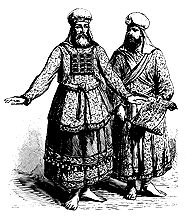 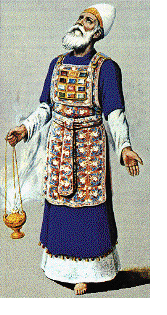
References in the Bible
URIM and Thummim
1) Placed in the breastplate of the high priest # Ex 28:30 Le
8:8
2) God to be consulted by # Nu 27:21
3) Instances of consulting God by # Jud 1:1 20:18,28 1Sa
23:9-11 30:7,8
4) Sometimes no answer by # 1Sa 28:6
5) Were wanting in the second temple # Ezr 2:63 Ne 7:65
6) Illustrative of the light and perfection of Christ, the true
high priest # De 33:8
Joh 1:4,9,17 Col 2:3
Bibliography
The Breastplate of the High Priest: Which Tribe to Which
Jewel?, by F. Graham Millar
Dress & Breastplate of the High Priest, by Edward Rogers
Gearheart
Freemason’s Book of the Royal Arch, by Bernard E. Jones
A Dictionary of Freemasonry, by Robert Macoy
The High Priest and his garments, by Martyn Barrow
The Curious Lore of Precious Stones, by G. W.
Kunz back to top |
![]()










